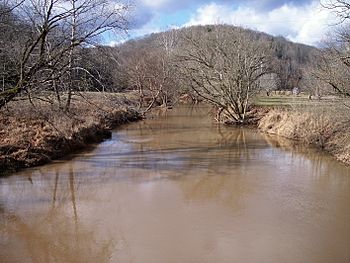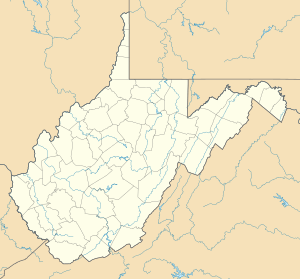Cedar Creek (West Virginia) facts for kids
Quick facts for kids Cedar Creek |
|
|---|---|

Cedar Creek in Cedar Creek State Park
|
|
|
Location of the mouth of Cedar Creek in Gilmer County, West Virginia
|
|
| Country | United States |
| State | West Virginia |
| Counties | Braxton, Gilmer |
| Physical characteristics | |
| Main source | west of Flatwoods 1,306 ft (398 m) 38°43′31″N 80°39′48″W / 38.7253768°N 80.6634283°W |
| River mouth | Little Kanawha River west of Glenville 696 ft (212 m) 38°56′27″N 80°55′15″W / 38.9409221°N 80.9209396°W |
| Length | 31.7 mi (51.0 km) |
| Basin features | |
| Basin size | 81 sq mi (210 km2) |
Cedar Creek is a cool waterway in central West Virginia, United States. It's like a smaller stream that flows into a bigger one, the Little Kanawha River. Cedar Creek is about 31.7 miles (51 km) long.
This creek is part of a huge water system. Its water eventually joins the Ohio River and then the mighty Mississippi River. This whole area, called a watershed, covers about 81 square miles (210 km²). It's a mostly rural area on the Allegheny Plateau, which means it wasn't shaped by glaciers.
Contents
About Cedar Creek
Cedar Creek starts its journey about 1 mile (1.6 km) west of a town called Flatwoods. This starting point is in Braxton County. From there, the creek flows mostly towards the northwest.
Where Does it Flow?
As Cedar Creek travels, it enters Gilmer County. It passes through a small community named Cedarville. The creek also flows right through Cedar Creek State Park, which is a great place to visit.
Finally, Cedar Creek meets the Little Kanawha River. This meeting point is about 5 miles (8 km) west of Glenville.
What's Around the Creek?
The land around Cedar Creek is very natural. The West Virginia Department of Environmental Protection has studied this area. They found that most of the land, about 90.5%, is covered in forest. These forests are mostly made up of deciduous trees, which are trees that lose their leaves in the fall.
The rest of the land, about 9.2%, is used for farming. This includes areas for pasture where animals graze and other agriculture uses.
How Cedar Creek Got Its Name
The name "Cedar Creek" is quite simple! The creek was named because of the many cedar trees that grow along its banks. These trees gave the creek its unique and fitting name.


